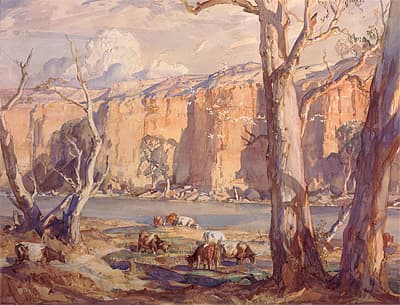Hans
HEYSEN
Germany
1877
–
Australia
1968
Australia from 1884; Europe, England 1899-1903
Murray River cliffs
1916
watercolour on paper
78.0 (h)
x 92.0 (w)
cm
Gift of Howard Hinton 1939, Collection: New England Regional Art Museum
Family life at The Cedars was always at the heart of his work, and until 1926 the main area of focus for Heysen’s art was Hahndorf and the nearby areas of the Adelaide Hills. However, his subjects also extended to other regions. From 1915 to 1917 Heysen went on four painting trips to the Murray River—totalling about three months of sketching time—travelling by paddle steamer from Murray Bridge upstream to Nildottie. A letter written by his wife Sallie to their children in 1915 described ‘... great walls of cliffs shining all gold and red—they look just like the pictures of the old castles with turrets and battlements straight as a wall .... ‘[1]. The large watercolour Murray River cliffs, 1916 shows the vertical amber-coloured walls, illuminated with rich tones, precipitously towering over the waters. Foreground cattle grazing on lush river flats are framed by signature gums on the left and right. Across the river, distant trees and shadows cast by buttresses of rock create the effect of tapestry on a castle wall.[2]
The paintings of Murray River cliffs evoke Heysen’s much earlier sand-carting subjects from 1906 at West Beach, Adelaide, where great masses of glowing golden sand dunes dominate the scene of horse-drawn labour. A similar high-horizon study of light on coloured earths or rocks is found in his paintings of quarries at Crafers, in the Adelaide Hills, such as The quarry 1922, where vast quantities of bare, luminous rock fill the composition.
© Art Gallery of South Australia, Adelaide, 2008
Andrews, Hans Heysen, exhibition book, Art Gallery of South Australia, Adelaide, 2008, p 72
[1] Quoted in Thiele, p 174
[2] River Murray watercolours were singled out in reviews of Heysen’s 1928 Sydney exhibition (‘Mr Hans Heysen’s pictures’, Sydney Morning Herald, 14 June 1928, p 8 col f
